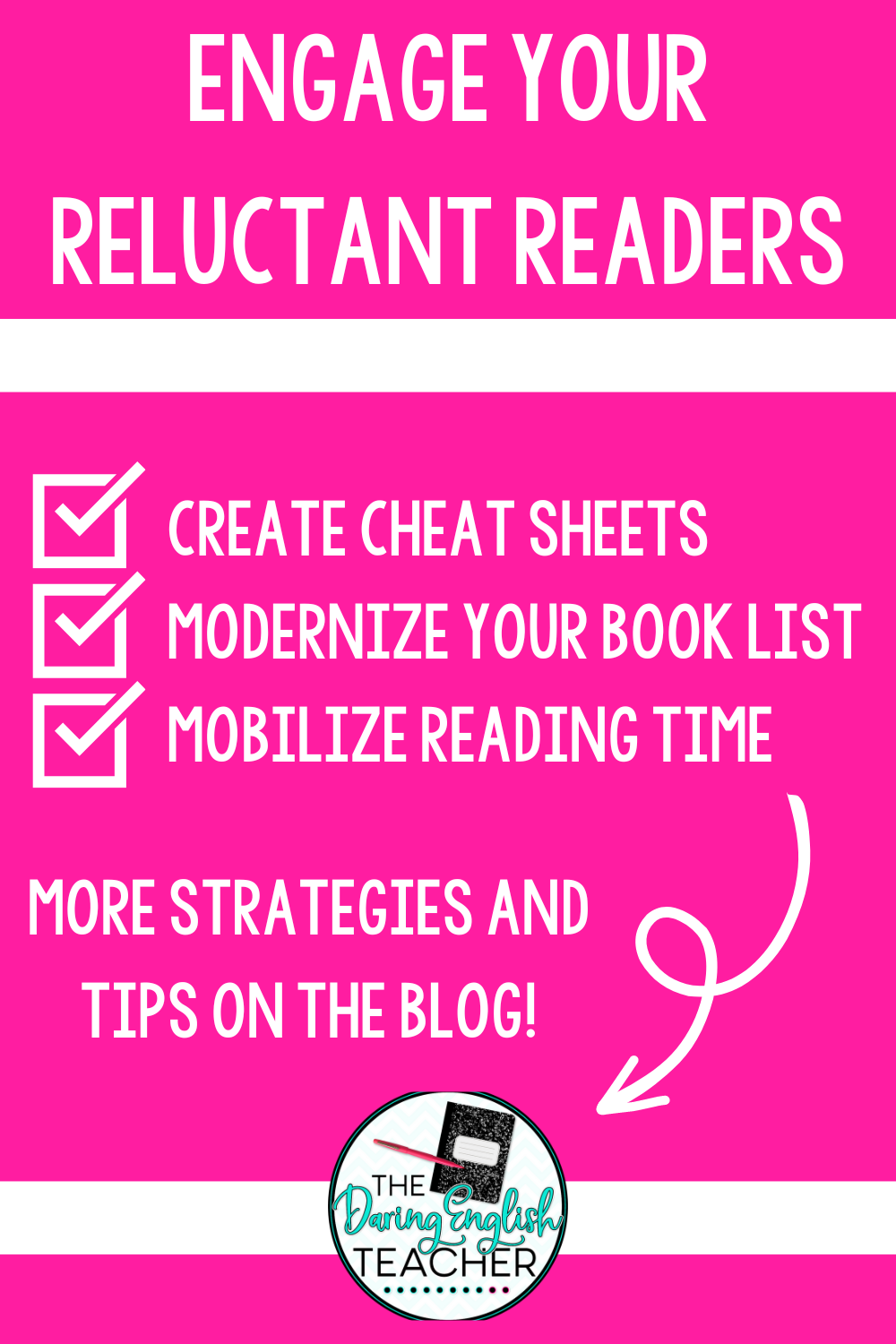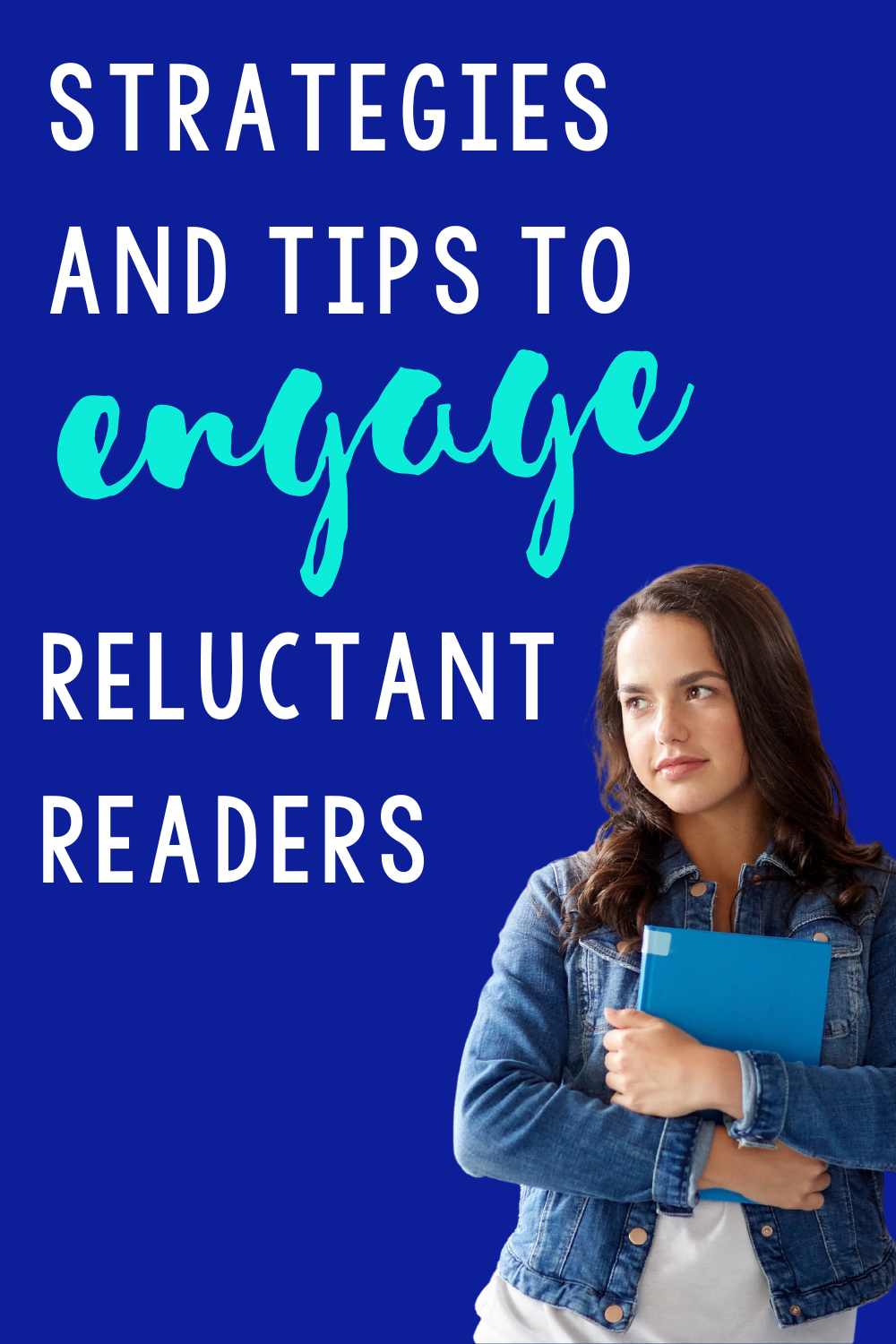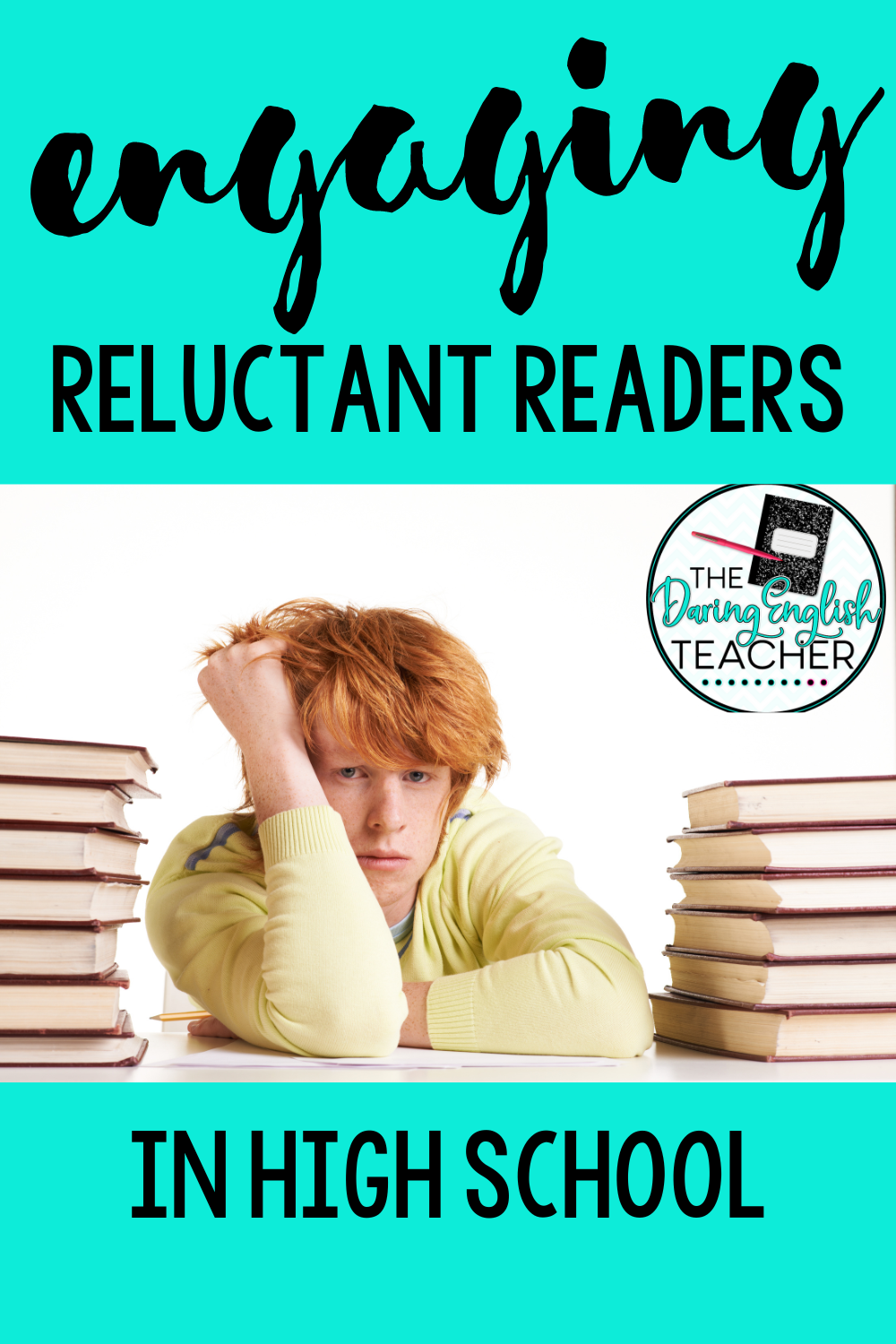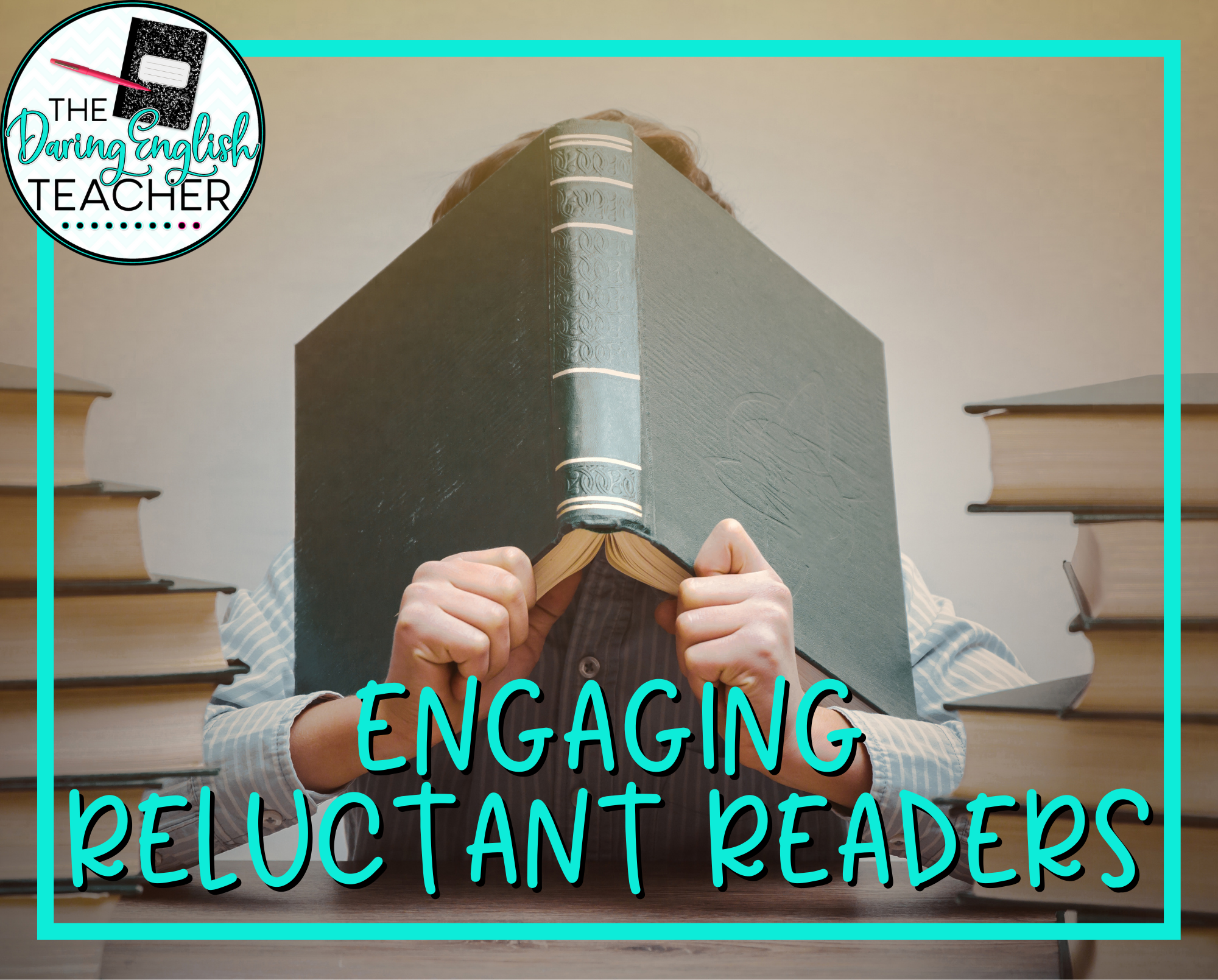I sure wish my students inherently loved to read, and they all had wicked vocabulary skills, and I never had to convince them that a text was worthwhile of their time. If they did, that would make engaging reluctant readers much easier.
But that’s hardly ever the case, and more often than not, I have varying degrees of reluctant readers in my classroom. So the question becomes, How do I engage my reluctant readers? By the time students are in high school, they usually have a long history of not enjoying the reading requirements in school. And honestly, every student will probably be a reluctant reader at some time because they all have their own interests, experiences, and abilities. So what is a teacher to do?

Why are students reluctant?
Your strategies won’t get you far if you don’t get to the principle problem. Unless you happen to hit on the issue, spending your time looking up tips isn’t going to help your students long term. Look for any reason so you can personalize your solutions. Are there specific reading skills the student is struggling with? Is this a topic that is hard to identify with? Are there tasks associated with the reading that is keeping them disinterested? Perhaps the assignments themselves create a stress for students, such as requiring the class to read aloud. Is the text chosen something above their reading level?
Once you key in on the main issue, you’ll be better prepared to plan how to motivate your students.
9 Strategies for Engaging Reluctant Readers
Always Plan on Differentiating
If you haven’t planned for a potential problem, it is much harder to solve “in the moment.” This is why we, as teachers, spend a lot of time working on differentiating. You might be used to doing this with activities and writing expectations, but what about the text itself? Spend time looking at the text you’ll be reading and preemptively make plans to make it work with your students’ varying needs.
Keep It Short
Do your students need to read the whole text? Oftentimes you can flip through a textbook and see short snippets of longer works so students just “taste” the text before diving into the discussion. Interested students can dive deeper by reading a whole text, or you can offer enrichment activities for students who want to read more.
But if you can, pull the most meaningful excerpts and have the class work with those. Bite-size pieces are easier to work with, and students may feel more motivated seeing a shorter section of text rather than a novel.
Give Them Different Tasks
I don’t believe all my students need to do the exact same assignment to do the same work. It doesn’t make sense for my advanced students to breeze through an activity that takes some struggling students twice as long with twice as much work to complete. I have no issue grouping my students and, occasionally, giving them different assignments to work on.
A really great way to encourage reluctant readers is not to have them read the book at all. That’s right. Create a “Special Task Force” of students who will be working on the extra supplemental material for the class. Rather than the whole class reading an article accompanying the text, have your special group read ahead and present the material for everyone. This can be particularly helpful with period pieces with unfamiliar vocabulary or works with complex plots and discussions your reluctant readers may not be ready for. If you make this part of your reading groups the whole year, you can swap which students are in this particular group as you get to texts of varying levels.
Create Cheat Sheets
I’m not saying rely on Spark Notes. However, we know students refer to it, so use the concept to your advantage.
Students that can’t understand the material aren’t going to get far with any reading or assignments. I like to create Cheat Sheets (which can benefit all my students). These might include important vocabulary, especially if students need to understand period or subject-related vocab. You can also include fast facts about characters, relationships, or major plot points.
Make them cute and cut to fit the book so students can tuck it into it and refer to it as they read.
Find Something Similar
Oftentimes I don’t think it’s necessarily about reading this book title. It’s about the concepts, the characters, the lessons learned. So if we can read a more modern work and get the same things out of it, why not? I really don’t see a problem with having students read adaptations, modern retellings, and other period pieces that are easier to read when it comes to my reluctant readers. Even my advanced students might enjoy the change of pace. I also find that modern works tend to have a faster pace, which usually automatically gives me more engagement.
Don’t Overlook the Book
The way your books and text look is going to make a difference. If you clonk a big, dusty novel on the desk of your reluctant readers, how well do you think they’ll listen? Flip through your text and look at the layout. Is the font really crowded? Is it printed too small? What kind of distractions are there (footnotes, images, copied notes from years gone by)? Is it broken up effectively?
I had a teacher in high school who liked having us take notes on the pages. So she would make copies of these articles but they were printed very small so that we had margins around the text to write. It was a great activity in theory, but even an avid reader like myself dreaded getting the packets of tiny words.
Read for Fun
Teaching your students that reading can be enjoyable is really the lifelong skill we want to see. If you work on a particularly long or difficult novel, let students work in literature circles with some choice reads. Find a set of contemporary novels that fit in with the unit’s theme. Or, establish a set “free read” day that your students look forward to. For many years, that was Friday in my classroom. We loved taking a break and heading to the library as a class, or just having a quiet hour in the classroom to read whatever we wanted. I was able to establish a really good relationship with students as they gave me suggestions on what to read, and I made sure to read their suggestions and give them my honest review. It’s a great way to model reading different genres and how to have a real discussion about what you read.
It’s important to note as well that free reading doesn’t have to mean novels. I often saw my reluctant readers bring in magazines on interesting topics, and I was completely fine with that. Reading is reading. I’ve even had a student come in with a stack of cookbooks looking to build a meal for an upcoming Home Ec assignment.
Get Social
Have students work on social sharing what they read. Give students ownership of the information they know. It doesn’t always have to be you as the teacher leading instruction, discussion, and lecture. Let peers lead the way. Your more advanced students might lead a discussion topic in groups while a reluctant reader helps take the notes (so they can listen and write the information as well as participate without feeling on the spot with answering). Groups with varying reading levels create a valuable experience for all students.
Make It Mobile
Reading is mostly a passive activity – so what can you do to provide movement? Download an audiobook and have students walk laps outside or down the hallways. Do you have flexible seating options so students can move around wherever they are most comfortable? Do you have a box of fidgets students can grab as they read? All of these are great ways to get some movement with reading.
What are the best activities you’ve found for encouraging your reluctant readers? Have you tried any from this list? I love outside-the-box ideas and adding to my own toolbox of things to use in my classroom. Share your best suggestions here or over on Facebook and Instagram.
My Favorite Book for Reluctant Readers
My absolute favorite book to teach in a class filled with reluctant readers is Jason Reynolds’ novel Long Way Down. Every single time I teach this novel, students who claim they hate books and hate reading absolutely love it. They are completely engaged in the story.
You can check out my unit for teaching Long Way Down here. Also, be sure to check out my blog post about 25 ideas for teaching Long Way Down!



2 Comments
I appreciate your initial focus on determining the root of the problem. Understanding the why of actions and behaviors is so important when working with people. Building connections is an essential aspect of educating students because we need them to be comfortable with us enough to come to us with struggles or allow us to help when we identify one of their struggles. I, too, strive to demonstrate a love for reading and make reading experiences fun for students engaging with me. I have also used audiobooks to aid students in reading. I do not always have time to sit down and read a book when the urge strikes, but I can play the audiobook while completing other tasks. We can integrate digital tools to interact with the books, either for reading books with features like a one-touch dictionary, or students can complete different activities that require knowledge of the book, digital literacy, and collaboration. Students can work together to create a new, digital book cover and then give explanations to justify their creative decisions.
This approach to engaging reluctant readers sounds comprehensive and effective! Have you ever come across the Grandomastery random article activity? It might align well with the strategies described above.